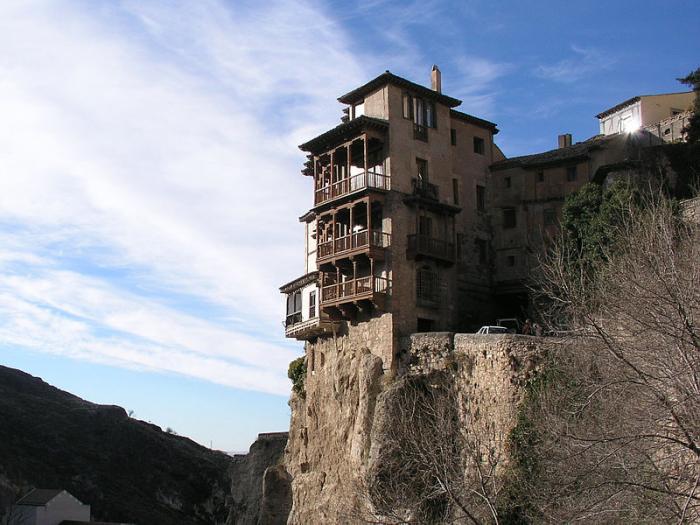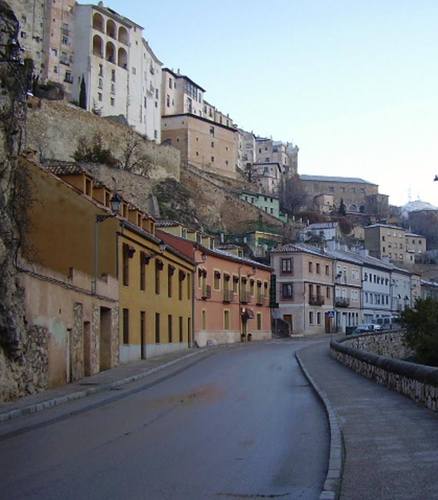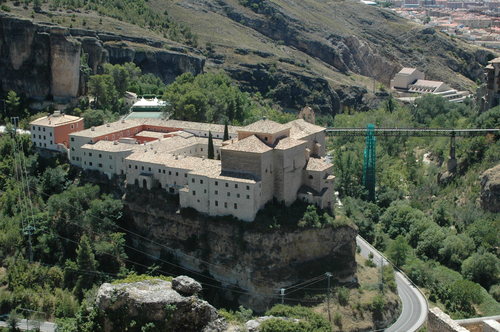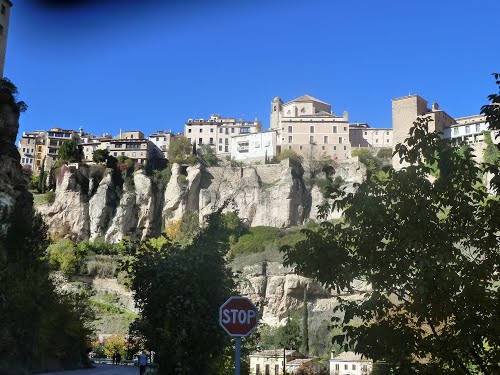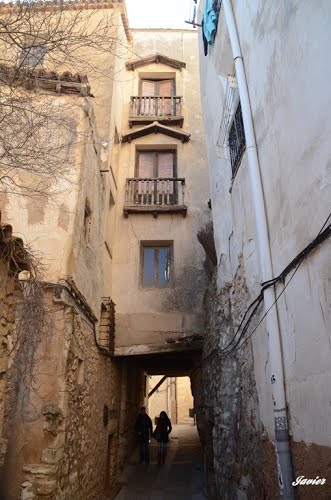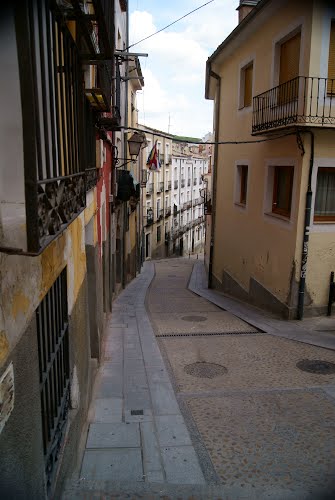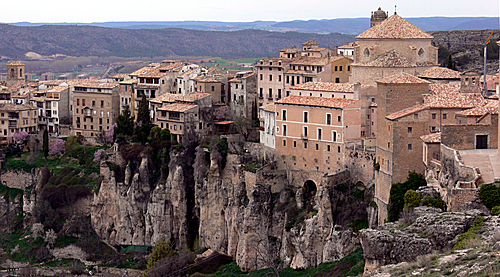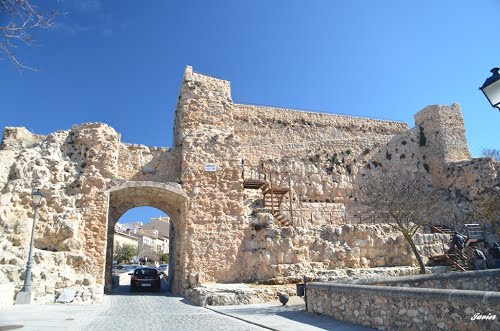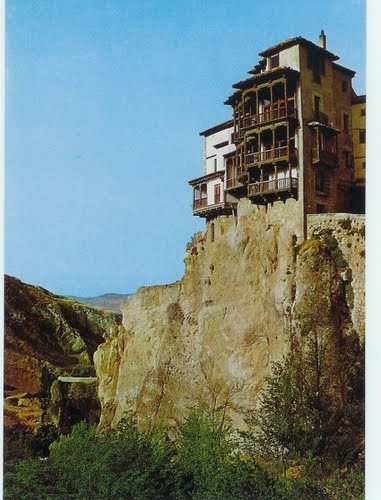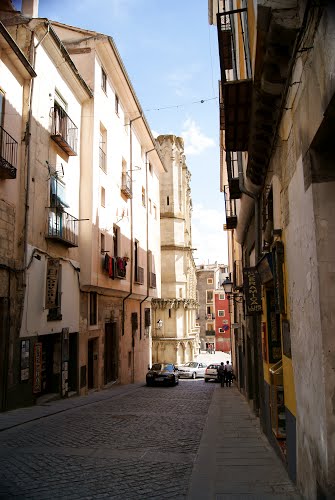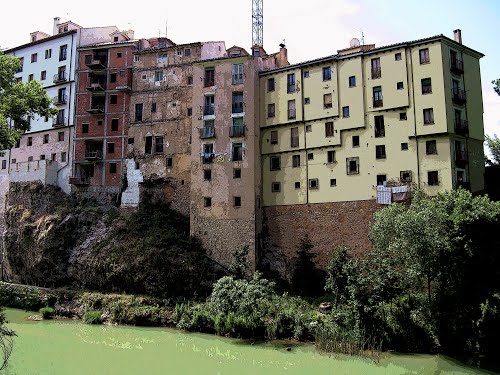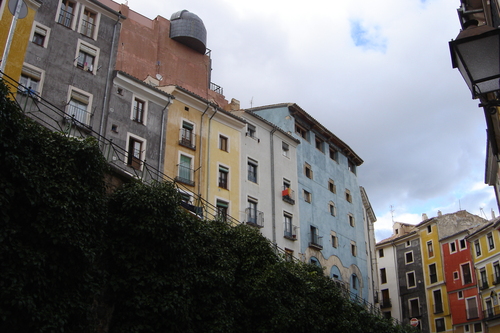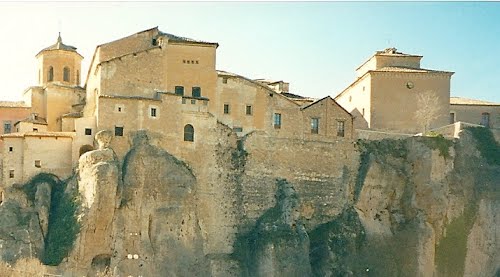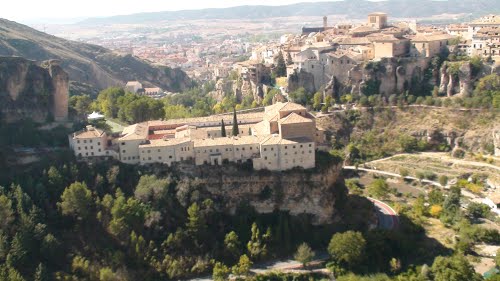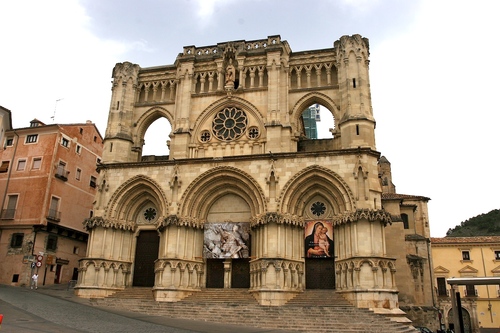Cuenca is a city in the autonomous community of Castile–La Mancha in central Spain. It is the capital of the province of Cuenca.
History
When the Iberian peninsula was part of the Roman Empire there were several important settlements in the province, such as Segobriga, Ercavica and Gran Valeria. However, the place where Cuenca is located today was uninhabited at that time.
When the Muslim Arabs captured the area in 714, they soon realized the value of this strategic location and they built a fortress between two gorges dug between the Jucar and Huecar rivers, surrounded by a 1 km-long wall. Cuenca soon became an agricultural and textile manufacturing city, enjoying growing prosperity.
Around the 12th century the Christians, living in northern Spain during the Muslim presence, started to slowly recover the Iberian peninsula. Castile took over western and central areas of Spain, while Aragon enlarged along the Mediterranean area. The Muslim Kingdom, Al-Andalus, started to break into small provinces under Christian pressure, Cuenca being part of the taifa of Toledo. In 1076 it was besieged by Sancho Ramirez of Aragon, but not conquered. In 1080 King Yahya al-Qadir of Toledo lost his taifa, and his vizier signed in Cuenca a treaty with Alfonso VI of Leon and Castile by which he ceded him some fortresses in exchange of military help.
After Alfonso's defeat in the battle of Sagrajas (1086), Cuenca was captured by the king of Seville, Al-Mu'tamid ibn Abbad. However, when his lands were attacked by the Almoravids, he sent his daughter-in-law Zaida to Alfonso, offering him Cuenca in exchange of military support. The first Christian troops entered the city in 1093. However, the Almoravids captured it in 1108. Their governor in the city declared himself independent in 1144, followed by the whole Murcia the following year. In 1147 Muhammad ibn Mardanis was elected King of Cuenca, Murcia and Valencia. He had to defend his lands from the Almohad invasion until his death 1172, after which his son had to sign a pact of tributes with the newcomers. A 17-year-old Alfonso VIII of Castile tried to conquer the city, but after five months of siege, he had to retreat after the arrival of troops sent by the Almohad caliph Abu Yaqub Yusuf. Alfonso signed a 7-years truce but when, in 1176 the Cuencans occupied some Christian lands in Huete and Ucles, Alfonso intervened at the head of a coalition including also Ferdinand II of Leon, Alfonso II of Aragon and the Military Orders of Calatrava, Santiago and Montegaudio, besieging Cuenca for months starting from 1177's Epiphany. The city's commander, Abu Bakr, sued again the support of Yaqub Yusuf, but the latter was in Africa and did not send any help. After an unsuccessful Cuenca sortie against he Christian camp on 27 July, the besieged city was conquered by Alfonso's troops on 21 September 1177, while the Muslim garrison took refuge in the citadel.
The latter fell in October, putting an end to the Arab domination in Cuenca. Alfonso VIII granted the city a title, and it was considered to be "Muy noble y muy leal" (Very noble and very loyal). It was given a set of laws, the Fuero, written in Latin, that ruled Cuenca's citizens, and it was considered one of the most perfectly written at that period of time. The diocese of Cuenca was established in 1183, its second bishop was St. Julian of Cuenca, who became patron saint of the city.
During the next few centuries Cuenca enjoyed prosperity, thanks to textile manufacturing and livestock exploitation. The cathedral started to be built at that time, in an Anglo-Norman style, with many French workers, since Alfonso VIII's wife, Leonor de Plantagenet, was French.
During the 18th century the textile industry declined, especially when Carlos IV forbade this activity in Cuenca in order to prevent competition with the Real Fabrica de Tapices, and Cuenca's economy declined, thus losing population dramatically. During the independence war against Napoleon's troops the city suffered great destruction, and it made the crisis worse. The city lost population, with only around 6,000 inhabitants, and only the arrival of railroads in the 19th century, together with the timber industry, were able to boost Cuenca moderately, and population increased as a result to reach 10,000 inhabitants. In 1874, during the Third Carlist War, Cuenca was taken over by Carlist troops, supporters of Carlos Maria Isidro as king instead of the ruling Isabel II, and the city suffered great damage once more.
The 20th century began with the collapse of the Giraldo cathedral's tower in 1902, which affected also the façade. It had to be rebuilt by Vicente Lámperez, with two new twin towers at both ends of the façade which have remained unfinished without the upper part of them.
The first decades of the 20th century were as turbulent as in other regions of Spain. There was poverty in rural areas, and the Catholic Church was attacked, with monks, nuns, priests and a bishop of Cuenca, Cruz Laplana y Laguna, being murdered. During the Spanish Civil War Cuenca was part of the republican zone. It was taken in 1938 by General Franco's troops. During the post-war period the area suffered a major economic decline, causing many people to migrate to more prosperous regions, mainly the Basque Country and Catalonia, but also to other countries such as Germany. The city started to recover slowly from 1960 to 1970, and the town limits went far beyond the gorge to the flat surroundings.
Within recent decades the city has experienced a moderate growth in population and economy, the second one especially due to the growing tourism sector, and both of them fuelled by improvements in road and train communications. Cuenca has strongly bet on culture and as a result of this it was declared a World Heritage site in 1996. In the recent years, new cultural infraestructures such as the municipal Concert Hall or the Science Museum place Cuenca in a good position to apply for the title of European Capital of Culture in 2016.

